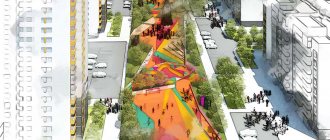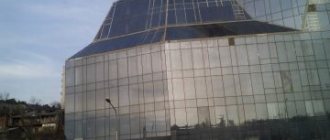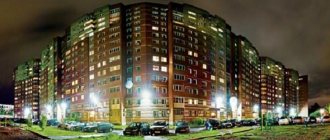For the improvement and development of the infrastructure of local areas, public places intended for recreation in cities and towns, funds are usually not allocated from local budgets or are provided on a residual basis. In accordance with the law, residents themselves are responsible for the condition of areas near apartment buildings. The funds they collect first go towards urgent needs for home repairs and renovations. The remaining small amounts may only be enough to paint benches or other minor work.
Based on this state of affairs, there is a terrible state of local areas and public recreation areas in the vast majority of settlements. To facilitate the solution of this problem at the local level, in 2021 a project was created and approved at the federal level to create a comfortable urban environment .
What is the essence of the courtyard improvement project?
The project was developed as an integral part of the state program of the Russian Federation “Providing affordable and comfortable housing and utilities to citizens of the Russian Federation.” It was approved by the Resolution of the Cabinet of Ministers of the Russian Federation dated December 30, 2017 (No. 1710).
In the order of the Ministry of Construction and Housing and Communal Services of the Russian Federation, signed on March 18, 2018. No. 162/pr, methodological recommendations for local governments were approved. The goal is to assist in carrying out activities in accordance with the program of human settlements of the country.
Indicators related to the implementation of the program are updated every year. The ambitious project in the period 2019–2024 provides for the improvement of 31 thousand public areas. This should increase the urban environmental quality index by 30 percent. It is expected that the share of residents participating in the project will increase to 30%.
For the specified period of program activities, it is planned to allocate federal budget funds in the amount of 269.3 billion rubles. They will be increased by adding 29.3 billion rubles from the consolidated budgets of the Russian Federation.
The funds are distributed as follows: amounts from the federal budget are transferred to the constituent entities of the Russian Federation. At the local level, they are supplemented by planned contributions, and a decision is made to finance certain cities and districts. Settlements with a population of more than 1 thousand people can participate in the project.
The initiative for repairs, landscaping, and improvement of areas near apartment buildings should come from residents . At a general meeting, they decide what exactly needs to be updated, repaired, and installed in the yard. They develop a project (prepare a drawing) of the future local area with all the objects drawn. They approve the improvement plan by decision of the general meeting and submit an application to the municipal authorities.
The deadline for submitting an application is until September of the current year . If the documents are properly completed and there is a reasoned justification for carrying out the planned improvement activities, the yard will be included in the financing program for the next year. That is, if the application is submitted before September 2021, then funds for repair, construction and improvement work will be allocated in 2021.
Accounting for individual works
Road development is regulated by Letter of the Ministry of Finance No. 02-06-10/39403 dated September 23, 2013. In paragraph 45 of Instruction No. 157n, fixed assets inventory items are taken into account on the basis of the provisions of the Classifier of Funds OK 013-94, established by Gosstandart Resolution No. 359 of December 26, 1994. This Classifier indicates that asphalting and road development will be taken into account as part of the operating system. They can be taken into account as part of other structures that are not included in other groups (code 12 0001090). That is, improvement objects (including roads) will be taken into account in the OS structure on account 0 101 03 000.
If roads and sites have a similar purpose and useful life, they must be taken into account as a group of objects. Data for each structure is recorded in the OS inventory card. However, experts recommend taking into account areas with independent purposes (for example, parking lots) separately.
ATTENTION! All the nuances of accounting must be specified in the acts of the organization.
Wiring used
When financing the improvement of the territory, these transactions are used:
- DT5 201 11 510 KT5 205 81 660. Subsidy receipt.
- DT5 302 31 830 KT5 201 11 610. Final payment after completion of all work.
- DT4 101 13 310 KT4 106 11 310. Acceptance of the object into the OS.
- DT5 205 81 560 KT5 401 10 180. Accrual of income from transferred subsidies or financing.
If the facility already exists and paving is carried out to improve performance, the costs are placed under subsection 225.
Rules for landscaping areas participating in projects
Based on the provisions of the order of the Ministry of Construction and Housing and Communal Services, improvement work is divided into two groups:
- The minimum type of work is paid from the Federal program. The state finances the repair of roads and driveways in courtyards, the installation of garbage containers, trash cans, benches, and the installation of modern area lighting systems.
- Funds from the local budget are allocated for additional improvement, and money collected by citizens living in this yard is also transferred. These types of work include installing a children's playground, creating a comfortable resting place for adults, designating and fencing an area for walking pets. In the plan of additional activities, residents can include the installation of parking spaces or parking inside the yard, as well as all landscaping activities (planting trees and bushes, planting flower beds).
The form and extent to which citizens will participate in the implementation of planned activities is determined by the decision of the relevant local administration bodies in each locality. For example, in the city of Irkutsk, residents take an active part in improving their own yard during cleanup days. The Samara city authorities decided that citizens need to contribute 1% of the amount of funds provided for additional types of work. This amount can be taken from funds transferred by residents to the management company account.
That is, co-financing for the implementation of the improvement program is provided from three sources: the federal, municipal budget and funds from citizens. To the question “is it legal to collect funds from residents for landscaping the yard in accordance with the federal program,” it is worth answering unequivocally, yes, it is legal. Only the degree of participation in joint financing for additional types of work is determined at the municipal level.
Accounting for expenses for the construction of objects
Objects can be understood as fences, benches, fountains, lanterns. Let's look at the types of objects and their OKOF codes:
- Paving slabs – 120001090.
- Metal fencing – 123697050.
- Other fencing – 124540000.
- Fountains – 120001090.
- Benches – 163612560.
Paragraph 38 of Instruction No. 157n states that objects of any value will be accepted for accounting as part of fixed assets (fixed assets) if these conditions are met:
- The useful life is more than a year.
- Operation based on operating instructions.
- Participation in the performance of services, functions, and meeting the needs of management.
Expenses for the creation of objects that meet the above conditions are placed in these accounts:
- 010611310 – for budgetary entities.
- 010611000 – for autonomous entities.
Items are placed on accounts at their original cost. These entries are used for accounting:
- DT2 106 11 310 KT2 302 31 730. Contributions to the construction of an object related to the OS.
- DT2 101 13 310 KT2 106 11 310. Acceptance of the object for accounting.
- DT2 302 31 830 KT2 201 11 610. Money was transferred to the contractor for the construction of the facility.
- DT2 109 80 271 KT2 104 13 410. Cost accounting in overhead expenses.
The main primary documents will be the contract with the supplier and receipts.
What yards are not accepted to participate in the program?
The decision to include a yard in the project is made at the budget level. In accordance with the terms of the project, the following list of restrictions has been established:
- if there are emergency buildings in close proximity to the yard that are subject to demolition during this period;
- when carrying out repairs or replacement of utilities running through the yard planned for a given year;
- if new buildings have been erected in the areas adjacent to the yard, in which the warranty period has expired upon commissioning;
- in the case when the types of work that the residents planned to carry out were already carried out at the expense of the local budget
It is recommended that you check with your municipality in advance about these restrictions.
Flower beds
Flower beds are an important element when arranging a yard. When the area is tiny, you can still find a place for flowers.
There are several types of flower beds:
- regular flower beds where a variety of plants grow, the flowering of which is observed at different specific times;
- irregular flower beds are planted with plants that bloom throughout the warm months of the year;
- raised flower beds are built from a variety of frames made of wood, metal, stone, brick;
- vertical flower beds decorate walls, low buildings and fences;
- carpet flower beds;
- monoflowers, consisting of only one type of plant;
- original borders;
- discount: different plants are planted on one side;
- arabesque: low-growing crops are planted in the form of various geometric figures;
- alpine slide: compositions of flowers, ornamental plants and stones;
- front gardens: plants are placed in front of the building and near the road;
- mixoborders: a composition of mixed plants, planted along houses, paths and fences.
Rights of residents when accepting work performed in accordance with the Program
As noted above, the initiative to include the courtyard in the “Formation of a Comfortable Urban Environment” Project comes from the residents of this house. The order of their actions is as follows:
- Check on the city administration website for lists of yards included in the local project for the current year.
- If there is no territory on the lists, it is necessary to unite with the residents of all residential buildings that are located on a common local area, in a common yard.
- Clarification of the question of what are the conditions for participation in the project in a specific locality.
- Determining the list of works related to minimal and additional measures for landscaping the yard.
- Conducting a general meeting of residents and voting. Moreover, the meeting must be held in person, but voting can take place in absentia. The initiative group visits residents in apartments and studies their opinions. Issues related to submitting an application for participation in the program, developing an improvement project, electing an initiative group and an authorized representative from a group of residents are discussed and accepted.
- Submitting an application (package of documents) to the administration of the locality.
- Monitoring compliance with the technology of repair, landscape, and installation work. Signing the act of acceptance of completed work.
An authorized representative from the residents' team constantly communicates with the foreman, monitors the progress and volume of planned work. Upon completion, a commission is created to accept the work and evaluate its quality. The commission includes representatives of the administration of the locality and an initiative group of citizens living in the yard.
If any planned activities are not carried out or the quality of the work is not satisfactory for the residents, they have the right not to sign the act or give consent to accept the work. If they disagree with the residents’ decision, citizens have the right to file a complaint against the contractor with the city administration or the Ministry of Construction of the Russian Federation.
After the expiration of the Federal project “Formation of a Comfortable Urban Environment”, courtyards in which landscaping was carried out in accordance with this program will be transferred to the balance of residents.
Accounting for non-capital expenses
Non-capital expenses are expenses not related to immediate needs. That is, this is landscaping carried out for aesthetic purposes. The postings will be like this:
- DT91.2 KT60. Acceptance certificate for completed work.
- DT19 KT60. Allocation of VAT.
- DT91.2 KT19. VAT write-off.
- DT60 KT51. Payment for services of third party companies.
Expenses will not be recognized for tax purposes, since they are not directly related to the activities of the company.
How to write an application for improvement of a playground
To participate in the Federal project, an application is submitted to the municipal authorities, an application determining the priority of work to improve the local area. The application is a package of documents. To complete the package you should prepare:
- Minutes of the general meeting of residents with consideration of issues regarding the inclusion of the yard in the program, an agreed list of minimal and additional work, sources of financing (or working participation of residents) in additional activities;
- The decision to create an initiative group of residents and elect an authorized representative of the collective of citizens living in a given yard;
- Photographs of existing infrastructure facilities in the local area (in order to confirm the need for their repair, dismantling, and improvement work);
- A copy of the passport from the cadastre for the land plot of the house (houses);
- A copy of the technical passport of the house (houses);
- Certificate from the management organization indicating the deadline for putting the structure into operation
An application for participation in the program is submitted on behalf of the residents of the apartment building (houses) and is signed by an authorized representative elected at the general meeting. The application must indicate the order of implementation of measures to improve the territory with a request to consider this list at a meeting of the relevant commission of the administration of the locality.
Site development
When planning a house and yard, do not forget about the garden. Fruit trees and shrubs, vegetable beds are distributed in such a way that there is enough space and sunlight for all crops.
Sidewalks and garden paths
When landscaping a site, the first step is to build paths and divide the site into zones. And then they install fences, install a playground and arrange a recreation area.
Often, non-standardly laid paths become a decoration of the entire site. There are a lot of trail options. For their construction, tiles, paving stones, and cut stone are used. If you do the paving of the path yourself, then the only expense will be the purchase of materials.
Paths decorated on one or both sides with low green spaces look elegant.
You should not immediately purchase paving slabs for garden paths. Look for original options. Look on the Internet. For example, if there is a cut tree on the site, cut the trunk into circles and lay out a path. And fill the gaps with sand or bark.
The yard path depends on the material used. Classification of house paths:
- stone options: paving stones, pebbles, crushed stone, paving slabs;
- wood coverings: boards, log cuts;
- paths made of brick or concrete;
- paths made from scrap materials.
To visually divide the local area, low fences made of annuals, perennials and dense bushes are used. To surround a recreation area or sports ground, use a low picket fence.
Pergolas for paths and arches will become beautiful and original fencing.
For such structures, climbing roses, clematis, climbing morning glory, and ivy are used.









